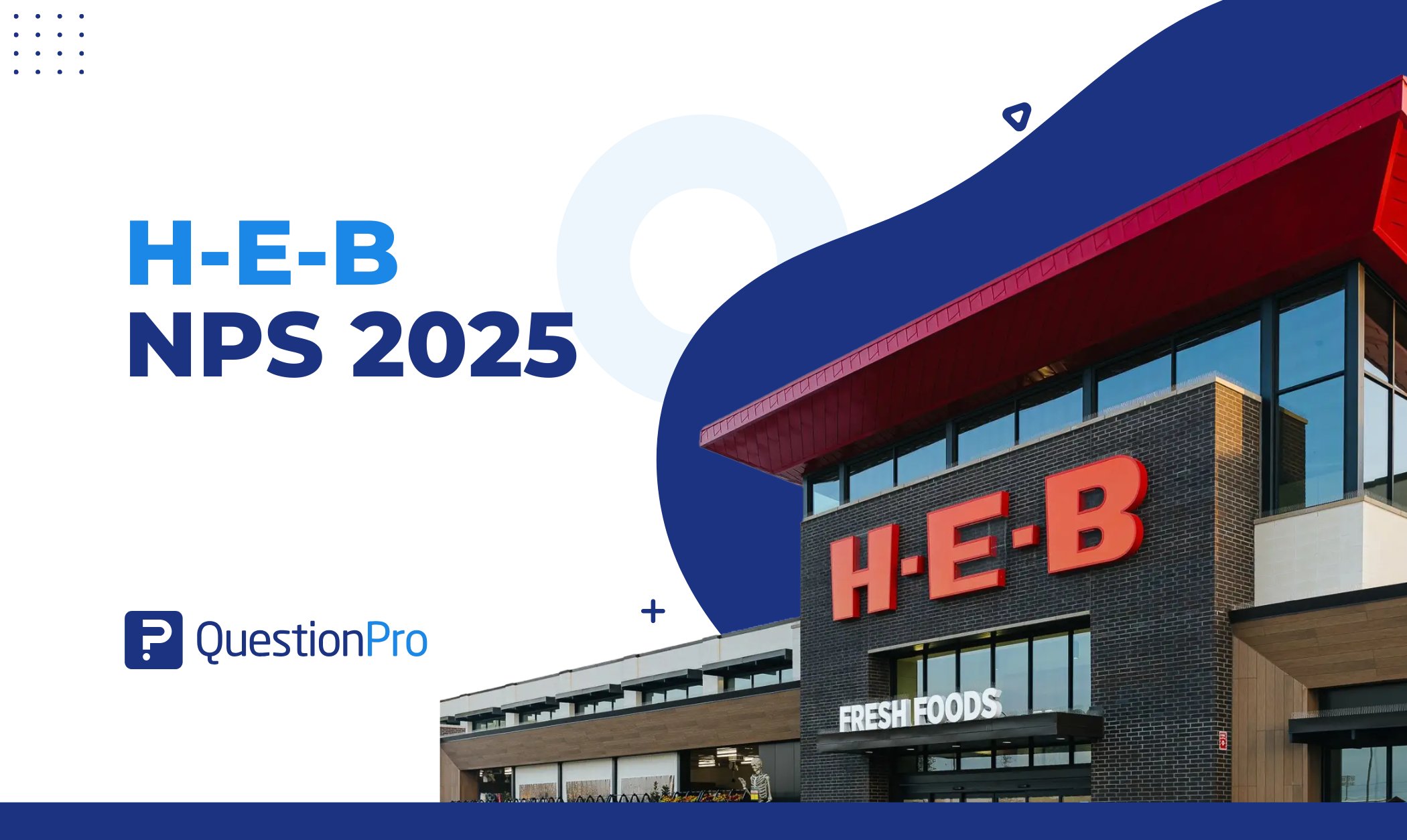
Customer satisfaction examples highlight the importance of customer-centricity in today’s corporate world. If you are running a business, it is essential to prioritize customer satisfaction. An organization’s success increasingly depends on customer-centricity and providing outstanding experiences that exceed customer expectations.
In this blog, we will present seven groundbreaking customer satisfaction examples of surveys and the key characteristics that help them improve and measure customer satisfaction.
What is customer satisfaction?
Customer satisfaction is the degree of how well customers’ expectations are met from a product or service.
While it cannot be touched and seen, it can be measured by collecting data. Companies can ask a series of questions to their customers, and based on their responses, it can be decided whether customers are satisfied or not.
An online survey is one of the most common methods of collecting customer satisfaction data. While there are several basic and advanced question types, the data collected by them can be primarily divided into two categories.
Quantitative data
Quantitative data is the value of data in the form of counts or numbers where each data set has a unique numerical value. This type of data can be quantified and used to generate statistical reports.
Qualitative data
Qualitative data is related to abstract concepts like emotions, expressions, etc., that cannot be generally quantified. However, with the latest developments in natural language processing and artificial intelligence, textual data can be used to extract meaningful insights from them.
Both quantitative and qualitative data are important and are used to get a holistic view of satisfied customers.
Why is customer satisfaction so important?
When you are in a situation where you have to pick and choose from numerous options, you need to create a niche for yourself.
Customer satisfaction KPIs can be a differentiator when you have to compete with other similar products. If someone has used your products or services and had a positive experience, they will choose your products or services over your competitors.
Customers are the lifeblood of your business. So, it is important to make them happy. Also, it is equally important that they remain satisfied. They must be requested for their feedback regularly to learn more about their customer journey.
The customer satisfaction survey helps you find out what areas they like about your products and services, but more importantly, what they would like to see improved. But you can derive the right insights from your survey only if the questions are phrased correctly.
Below are some surveys of excellent customer satisfaction examples that are great for getting ideas.
Free customer satisfaction survey templates
7 Groundbreaking customer satisfaction examples of surveys
Customer satisfaction surveys are now an important way to measure and understand customers’ happiness. On the other hand, traditional survey methods may not always catch the complex details of what customers want today. To get around these problems, companies are now using innovative survey examples that go beyond what has been done before.
Let’s look at seven innovative customer satisfaction examples of surveys that can change the process of measuring customer satisfaction.
01. Nike

Nike is considered one of the companies that give great importance to its customer’s feedback. Their customer satisfaction surveys aim to know more about the experience of their store visitors, and they are excellent customer satisfaction examples. However, many things about the store can affect a visitor’s decision to buy a product.
Some of the factors that can affect the satisfaction level of Nike customers who shop at the store are:
- Product placement
- Arrangement of products
- Range of products
- Staff behavior
- Staff service
- Staff greeting
- Store location
- Store facilities
- Store ambiance
Nike understands that because so many factors influence customer behavior and their decisions, there should be specific questions for each of them.
In the below example of a customer satisfaction survey, Nike asks targeted questions on how staff greetings affect their purchase decision.
The respondents can rate their experience on a scale ranging from not influencing at all to very strong influence. They can explain the reason behind their selection in the comment box and leave other comments. Such textual responses can be used for text analytics like sentiment analysis, word cloud, and other text analysis reports.
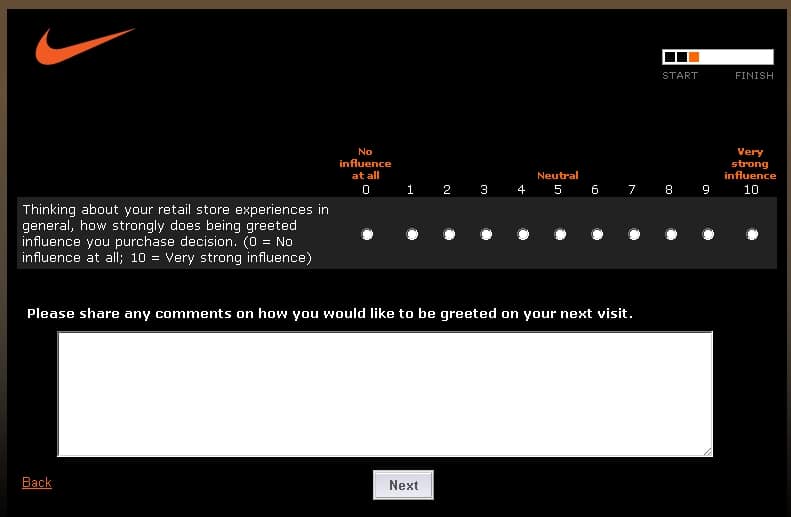

Key characteristics
- Helps segregate the feedback: As there are questions for different influencing factors, it’s easy to find out what feedback is for which factor. It makes generating reports easy and clear.
You can easily find the data that matters to you and thus save time in understanding the reports.
- Highlights specific improvement areas: In this customer satisfaction survey example, say, if the customer selected 8 or 9, which is close to a very strong influence, Nike would have asked its staff to continue greeting customers in the same way.
It implies that the staff greeting is a significant factor in generating sales and can also be applied in stores at other locations.
- Easy to find out which factor needs to be improved by how much: As the survey uses a numerical scale, the company can easily quantify how much a particular area needs improvement.
Also, it helps in comparing results with historical feedback. So, if there is an improvement of 4 points from 4 to 8, the company can be sure that customer experience has improved.
- Custom look and feel: This is another striking feature of the above questionnaire to match their brand style. Businesses like Nike should create branded surveys as they are touchpoints with customers. And just like their retail stores and website, they should also convey their brand voice through customer satisfaction surveys.
- Progress bar: The progress bar visually represents the survey completion percentage. It helps respondents to estimate how long it will take to complete the survey. This is an excellent example of customer-centricity, where the survey creator has designed the survey keeping its target users in mind.
Such survey design enhances the respondents’ overall experience and helps achieve a higher completion rate.
02. SubWay

SubWay uses an advanced grid to collect customer feedback. You can choose an option from the dropdown list for a specific service and select a rating based on your experience. You can also choose a reason for your rating from another dropdown list.
This is one of the most concise questionnaires of customer satisfaction examples. It makes the most out of the screen space and simultaneously gathers many meaningful responses from the respondents.
Such surveys have higher response and completion rates. Market researchers and organizations should use such designs to offer a great experience to their respondents.
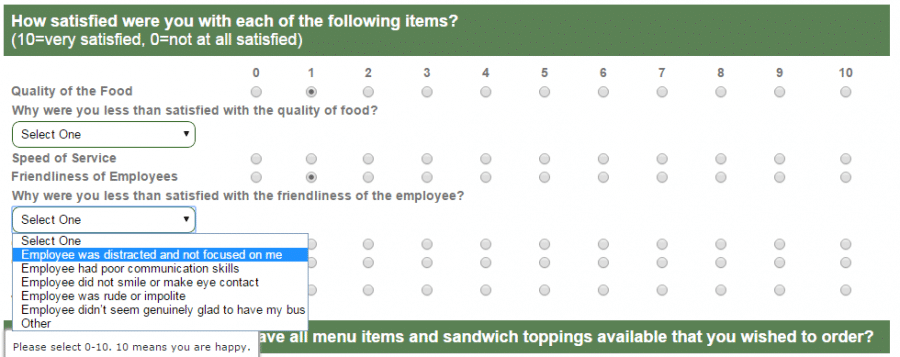
Key characteristics
- Short and crisp: Customer satisfaction surveys can get really long because an organization generally needs customer feedback about so many points. So, creating a helpful questionnaire for businesses is an art, and customers, too, would feel compelled to answer.
Here, SubWay has nailed the art and come up with a precise, compact, and aesthetically pleasing survey.
- Does not repeat scale labels: SubWay has used the header space to specify how they interpret respondents’ answers. Here, they have mentioned that 10 stands for very satisfied and 0 for a not satisfying experience.
As you can see, there are many questions that use a multi-point matrix scale with a scale of 0-10. Instead of repeating scale labels for all of them, they have specified it only at the top.
- Customized questions: To make the question relevant to each customer, SubWay has text piping in the question text. Many survey tools offer this feature, which substitutes text in place of a variable in the run time.
So, when the respondents answer the question, they feel as if the questionnaire has been customized for them.
- Relevant answer options: The dropdown list has answer options that can be quite possible scenarios or reasons behind their feedback. Both the questions and answers are well-phrased and are specific to their industry.
This helps them make better decisions and gather actionable intelligence from the results.
03. Delta Airlines

Delta Airlines is another business for whom customer experience and satisfaction matter greatly. They ask a series of questions that help them measure these parameters so that they can offer better services. Like Nike, there are many factors that affect the satisfaction of Delta Airlines customers too. Some of the most influencing factors are:
- The behavior of flight attendants
- Baggage allowed and its care
- Comfort of seats
- In-flight entertainment
- Meals
- Flight experience
Out of these, the behavior of flight attendants can be a differentiator when it comes to the passengers’ in-flight experience. So, Delta Airlines created a short yet detailed onboard service survey for its passengers.

Key characteristics
- Examples in the question text: Delta has given examples in the question text to make it easier for passengers to answer questions. It helps passengers decide the option and clearly understand the question.
- Aiming for the best: In the last question, instead of asking a generic question saying, “Do you have any other comments or suggestions for us?” Delta has asked a very specific question on whether they have met or exceeded the expectations of their passengers.
It sends a message that customer happiness is important to them. They aim to make themselves the best airline and so ask for specific feedback and suggestions that would make them the best. - N/A option: The survey creator understands that the question might not be applicable to the passenger, so to consider this scenario, they have added a N/A option as one of the answer choices.
04. McDonald’s

McDonald’s is a brand that spans across continents and serves a huge number of customers every day. Service is a key component of their business and massive success.
McDVoice, their online portal, lets customers enter the survey code from their receipts. It is convenient for customers to take surveys and show them that their feedback matters. It is important to note that customers can still provide feedback, even if a survey code is missing.
What’s even more noteworthy is that they show the respondents where they will locate the details they need to fill in the survey. These details can further help them filter responses and have a more detailed view of the data.
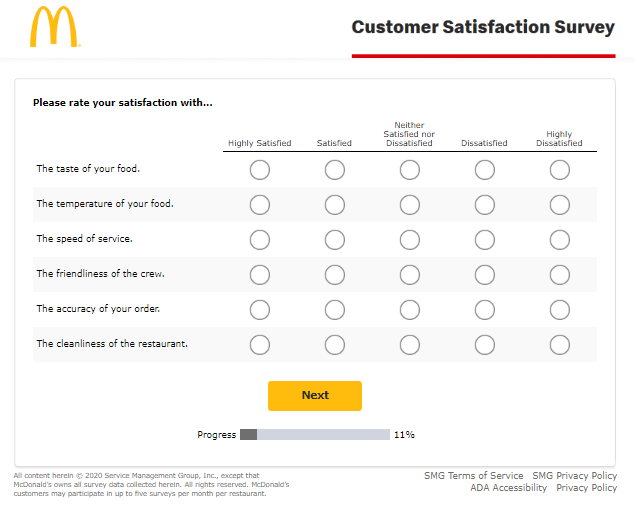
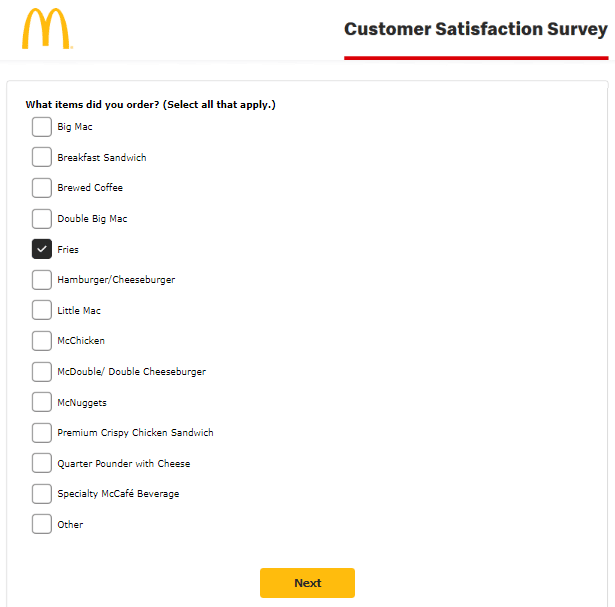

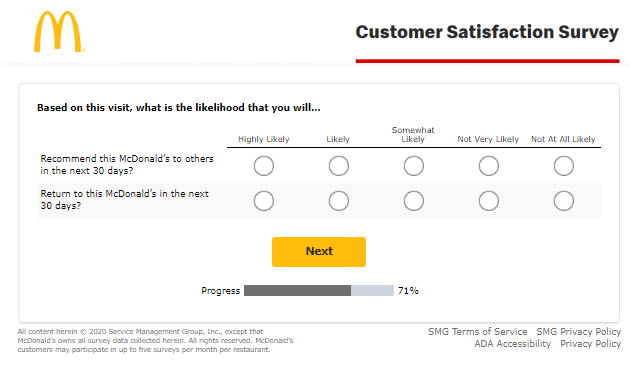
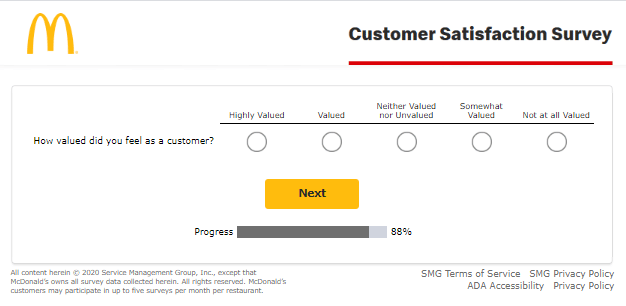
Key characteristics
- Brand themes: The survey template bears their logo and also follows their brand colors and themes. This lends authenticity and credibility to the survey template and improves the survey response rate.
- Simple select options: The survey has checkboxes as answer options that customers can easily select from. This is not cumbersome to the respondents, and does not take long to fill out the survey. Having this saves time, and then you can add an open-ended question in the end for more information.
- Shows progress: Almost all brands conduct customer satisfaction surveys. It is crucial to know what your customers are thinking and feel about your brand. The frequency of these surveys depends on organizations and their study focus. The customers, however, receive many surveys every day.
Ensuring your surveys are concise, numbered, and with a progress bar is crucial to reducing your survey dropouts. Having a progress bar lets the respondents know how many questions are left and improves your survey completion rates.
05. FedEx

To continually improve its services, FedEx conducts customer satisfaction surveys with all its customers, and they are great customer satisfaction examples. Their survey gets all the basic details from the initial questions, such as the type of service availed, the date and time of the visit, the transaction number, etc.
The respondents get to rate on a scale of 0-10, with 10 being extremely satisfied and 0 being extremely dissatisfied. They include a Net Promoter Score (NPS) question to see how likely their customers are to refer FedEx to their colleagues, friends, and family.
This helps them calculate their NPS score and buckets customers as promoters, detractors, or passives.

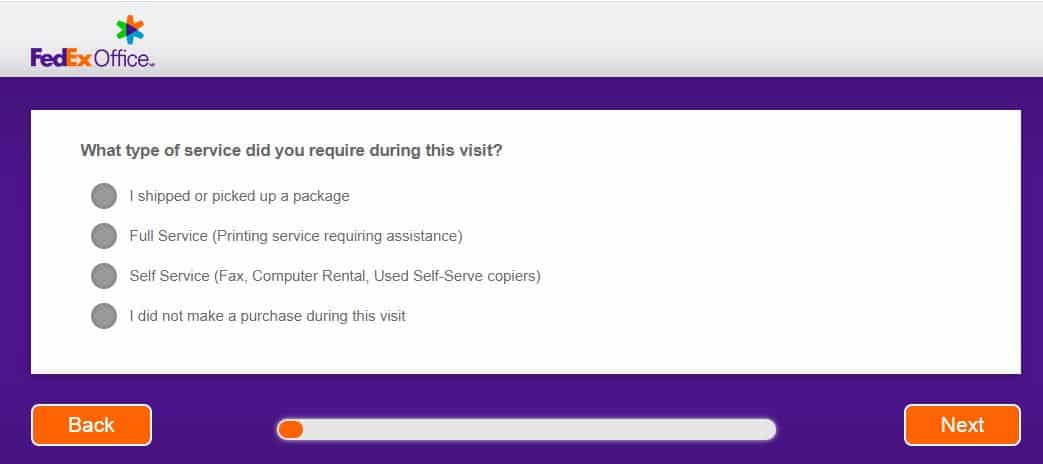

Key characteristics
- Get all information: Conducting customer surveys is not enough; you must also add customer feedback and concerns. By taking all vital information in the beginning, FedEx ensures that they can easily reach out to customers, get details, and address any concerns.
It also comes in handy to know what worked well for certain customers and replicate that for other customers. - Rating scales: The rating scales used by FedEx help customers select appropriate feedback. Using that information, FedEx can clearly see how satisfied or dissatisfied their customers are with their service.
- Journey bar: The customer survey indicates the survey’s progress, letting the respondents know the percentage of questions left. This helps ensure you do not lose respondents midway through and improves survey completion rates.
06. Walmart

Walmart has operations in many regions, which means they have customers who speak various languages.
With Walmart’s customer surveys, the customers get to select the language they wish to answer the survey in. This certainly helps in improving survey completion rates and getting honest responses.
Using multi-lingual surveys makes people comfortable and is definitely a great way to gather customer feedback.



Key characteristics
- Multi-lingual surveys: Walmart supports various languages for its customer satisfaction surveys. This is important to make your customers feel comfortable and to let them know that their opinions and feedback are immensely valued.
- Inspires honest feedback: Their surveys have language options, bear their logo, are easy to answer, and have a very good structural flow. All these factors inspire confidence among the respondents encouraging them to leave honest feedback.
This helps gather important and valuable information to refine its customer operations further.
07. Apple

Apple is famous for customer-centricity, and it reflects in its products and services. Their surveys are great as customer satisfaction examples. They have some of the most loyal customers globally.
Apple views customer experience with a different lens, and it shows in its marketing and customer service initiatives, echoing what Steve Jobs famously said, “You’ve got to start with the customer experience and work back toward the technology, not the other way around.”
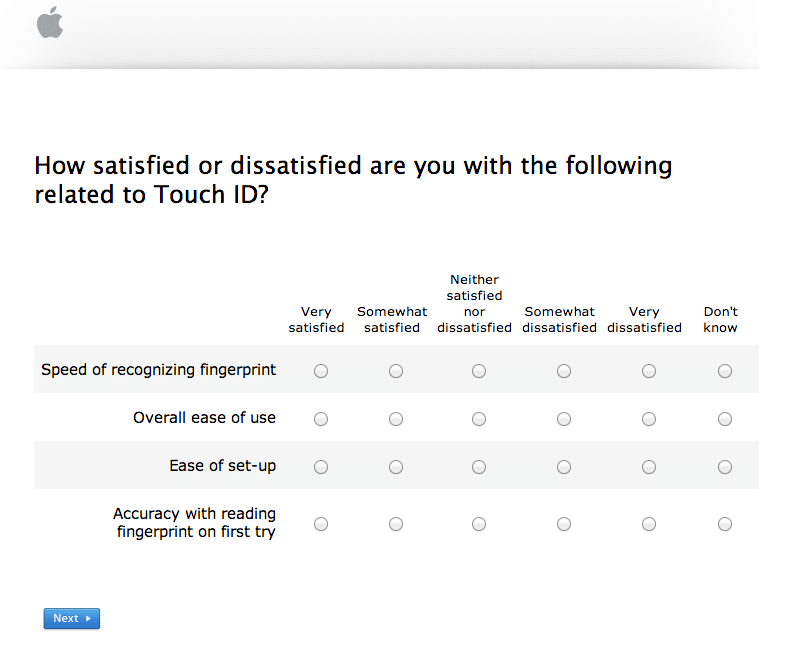


Key characteristics
- Get to the bottom: As you can see in the survey template, they have provided a multitude of options to the respondents. This helps Apple pinpoint reasons and get to the bottom of reasons for customers’ actions.
This data can come in handy in product development, marketing campaigns, customer churn initiatives, etc.
- Rating scales: They use rating scales to measure customer satisfaction and various other aspects, which are easy for the respondents to fill in. They also provide open-ended questions to get to the root of issues.
Respondents can choose to provide that extra information if they wish. These comments are crucial to zeroing in on specific customer issues and addressing them.
- Simplicity is key: Apple’s survey design and template are simple, avoiding distractions. This helps keep the respondents focused on the survey and achieve good survey completion results. Templates that use a lot of colors and themes tend to be distracting and off-putting.
How to create good customer satisfaction surveys?
Creating good customer satisfaction surveys is essential to understand and improve the customer experience. A well-designed survey can provide important insights into customer preferences, suggest areas for improvement, and measure overall satisfaction levels.
We looked at 7 Groundbreaking customer satisfaction examples. By following best practices and applying smart strategies, you can ensure that your customer satisfaction surveys produce valuable data that may drive actionable improvements inside your organization. Creating good customer satisfaction surveys that yield desired results depends on the below steps.
Step 01: Designing a survey
Designing a customer satisfaction survey offering significant insights and actionable data requires careful thought and planning. Here are some important factors to consider when creating a customer satisfaction survey that collects the information necessary and gives valuable insights for your organization.
Write short and clear questions.
Use a mix of simple multiple-choice questions and advanced question types like NPS, advanced grid, budget scale, etc.
The survey completion rate will drop if respondents see lengthy text or too many questions in the survey. Good customer satisfaction survey questions ask for just one piece of data and don’t have other questions nested within it.
Avoid using ‘and’ and ‘or’ in the text, as the data might turn out to be inconclusive. Avoid bias, double negatives, complex language, hypothetical questions, and difficult concepts.
Customize the look and feel
The way your survey looks can affect your response rate. A shabby-looking survey that is not neatly designed will repel respondents from answering the questions. It also spoils the brand image, and hence you can lose business.
Thus, your customer satisfaction survey can act as your business card, and so all efforts must be made to reflect your brand voice and style. Customize the font, color, theme, header, and footer, and add a logo to your customer satisfaction survey to look professional.
Add survey logic and programming
Let your respondents see only questions that are relevant to them. Redirect them to the right questions using skip logic, branching, show/hide questions and answer options, and randomize the order of both questions and answers to avoid any kind of bias.
Use ready-made templates
If you are not sure of what questions to include in your survey, use ready-made survey templates. Experts prepare these templates, which can be customized per your needs. They save time and are ready to use.
Step 02: Distribute a survey
Once you’ve designed your customer satisfaction survey, the next crucial step is to distribute it properly. Distributing your survey to the appropriate audience ensures you collect diverse responses that appropriately represent your consumer base.
Choose the right platform
Survey tools offer you many distribution mediums like email, mobile apps, websites, social media, and QR codes. Depending on where your audience is likely to answer, you can choose one of them. You can also keep the responses anonymous so your customers can give honest feedback.
Choose the right target audience
Targeting the right audience is crucial for the success of any survey. Select the right sample size such that it represents the target audience in appropriate proportion in terms of demographics.
Step 03: Analyze the results
Once you’ve collected a significant amount of survey responses, the next important step is to analyze the data to get valuable insights. Data analysis enables you to identify patterns, trends, and areas for improvement that can lead to significant changes in your business.
Generate reports
Generate a Customer Satisfaction Score (CSAT) from the responses received on a scale of “Not satisfied at all” to “Very satisfied.” Filter results to get a detailed view of how different groups of customers have responded. It gives a glimpse into their experience and whether there were any common influencing factors. Create data filters based on demographics, questions, device type, location, and more.
Conduct customer satisfaction surveys regularly and create reports like Trend analysis, survey comparison, word cloud, and text analytics reports. Compare results with the historical reports and see if there is any improvement. If so, it implies that the customer experience has enhanced, and hence their satisfaction too from your products and services has improved.
Integrate with third-party tools
To learn how your customer satisfaction survey results stand as compared to data from other sources, you can integrate your survey software with third-party applications like Salesforce, Microsoft Dynamics CRM, Marketo, Hubspot, Tableau, and more.
Also, you can automate your marketing activities based on customer responses. For instance, if the analysis of results points to the fact that a set of customers didn’t have enough knowledge of the product line, they can be sent targeted marketing emails automatically.
Export results
Export survey results in commonly used formats like .pdf, .doc, and .xls to share the results with the team and other stakeholders. You can also embed a link to your survey report on your website or share the URL on social media sites like Facebook and Twitter.
Step 04: Take action
Once you’ve reviewed the reports and identified areas for improvement, it’s time to create an action plan and put it into action. Taking action indicates your dedication to addressing customer concerns and consistently improving their experience.
Develop an action plan
Create a detailed action plan, including specific measures and initiatives to address the areas for improvement that have been identified. Establish defined goals, resources, and timetables for making changes.
LEARN ABOUT: Effective Customer Success Plan
Close the feedback loop
The whole point of conducting a customer satisfaction survey is to know whether your customers are happy. If not, find out what areas you can improve their experience.
You can get pointers from the survey and work on the improvement areas. According to a Gartner report, 95 percent of businesses collect customer feedback, but only 10 percent really use it.
Do not disappoint your customers by getting their feedback but not acting on it. The best businesses make sure they take action and convey the same to their customers.
Conclusion
Customer satisfaction is essential in today’s business environment, and companies must prioritize providing exceptional experiences that exceed customer expectations.
We explored seven innovative customer satisfaction examples of surveys, highlighting important characteristics that lead to their success. These examples show the significance of customized surveys that collect useful insights.
Businesses can gain a full insight into customer preferences, identify areas for development, and make practical changes to improve the customer experience by conducting carefully designed surveys and taking advantage of the data collected.





